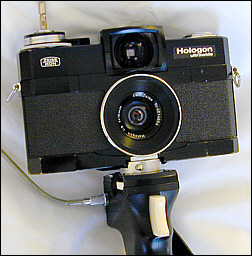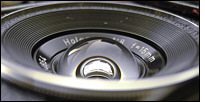Zeiss Ikon Contarex Hologon

|
|
|
| Style, film format | Ultrawide, 35mm |
|
|
|
| Lens, shutter | f/8 15mm Carl Zeiss Hologon, cloth focal-plane |
|
|
|
| Photo quality | Very wide, very good |
|
|
|
| Ergonomics | See text |
|
|
|
The Contarex Hologon is another oddity among the many Zeiss Ikon cameras. Arriving near the end of the company's existence, the Contarex Hologon offered a 110-degree angle of view with this special triplet lens.
The camera is best used when mounted on a grip that keeps the hands beneath the camera rather than on the sides, where it's all too easy to photograph your knuckles.
The camera uses a cloth focal-plane shutter with speeds running from 1/500 plus B and T, rather than the usual Contarex range that extends to 1/1000. Aperture is fixed at f/8. You set correct exposure by adjusting the shutter speed.
 I
haven't disassembled the lens, but I can say from visual inspection that
the front and rear elements are hemispherical, which you can see in the
photo.
I
haven't disassembled the lens, but I can say from visual inspection that
the front and rear elements are hemispherical, which you can see in the
photo.
A special graduated neutral density filter was sold as an accessory for use with transparency film. It probably would be OK to leave on the camera at all times.
The Hologon kit included the Zeiss Ikon grip and shutter release cable, the ND filter and a very nice case to hold everything.
The lens has such expansive depth of field that there is no need to focus. Depth of field extends from 0.5 meters to infinity. I often call the Hologon one of the most expensive point and shoot cameras in history.
Obviously, with a lens that provides this amount of coverage, flare is going to be an issue. And there is no lens shade. I suppose it would have to be the size of a dinner plate, and then it wouldn't be effective. The lens does flare, although it's not too objectionable, but you need to be mindful of where the sun is when shooting.
The viewfinder covers 110 degrees, and there is noticeable barrel distortion. A bubble level can be seen inside the viewfinder and from the top of the camera, which is useful when the camera is mounted on a tripod.
The Hologon useds many of the standard Contarex accessories, including the interchangeable backs, universal handgrip, film cassettes (from the Contax rangefinder) and data strips. The handgrip is highly recommended to avoid photographing your knuckles.
When Zeiss Ikon folded in the 1970s, parent firm Carl Zeiss completed production of some of the Hologons. And some lenses were refitted to the Leica M mount, making it one of the only Carl Zeiss-branded production lenses for the Leica M (until the release of new Carl Zeiss glass in 2005).
The Hologon (in lens form only) returned for use with the Kyocera Contax G system, albeit as a 16mm lens.
Photos
Image quality is quite good, considering that it's a fixed focus lens with depth of field that extends from roughly 19 1/2 inches to infinity. Of course, it's a Carl Zeiss lens, so you would expect performance from this camera to be better than your run-of-the-mill cheapie. This is a camera that demands your attention. It performs best when held parallel to the horizon, although you can get some very interesting effects by tilting the camera off axis -- which you can see below.
• NEW: See a slideshow (Ilford FP4+, 2006)
 The front yard |
 Happy Halloween |
 Night driving |
 Lesson over |
 Pat on the nose |
 Turning away |
 Some flare |
 More flare |
 White horse |
 Three horses |
